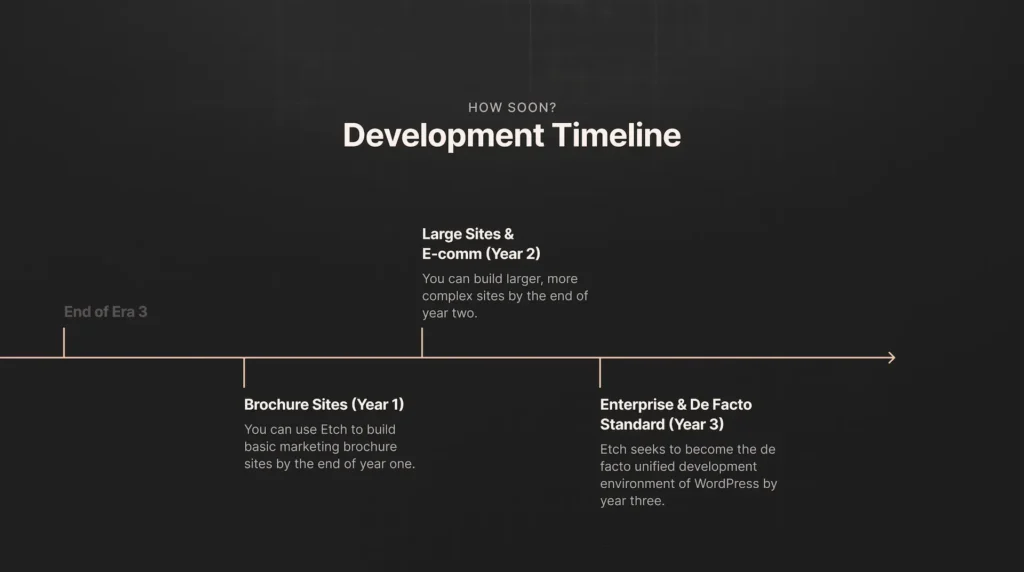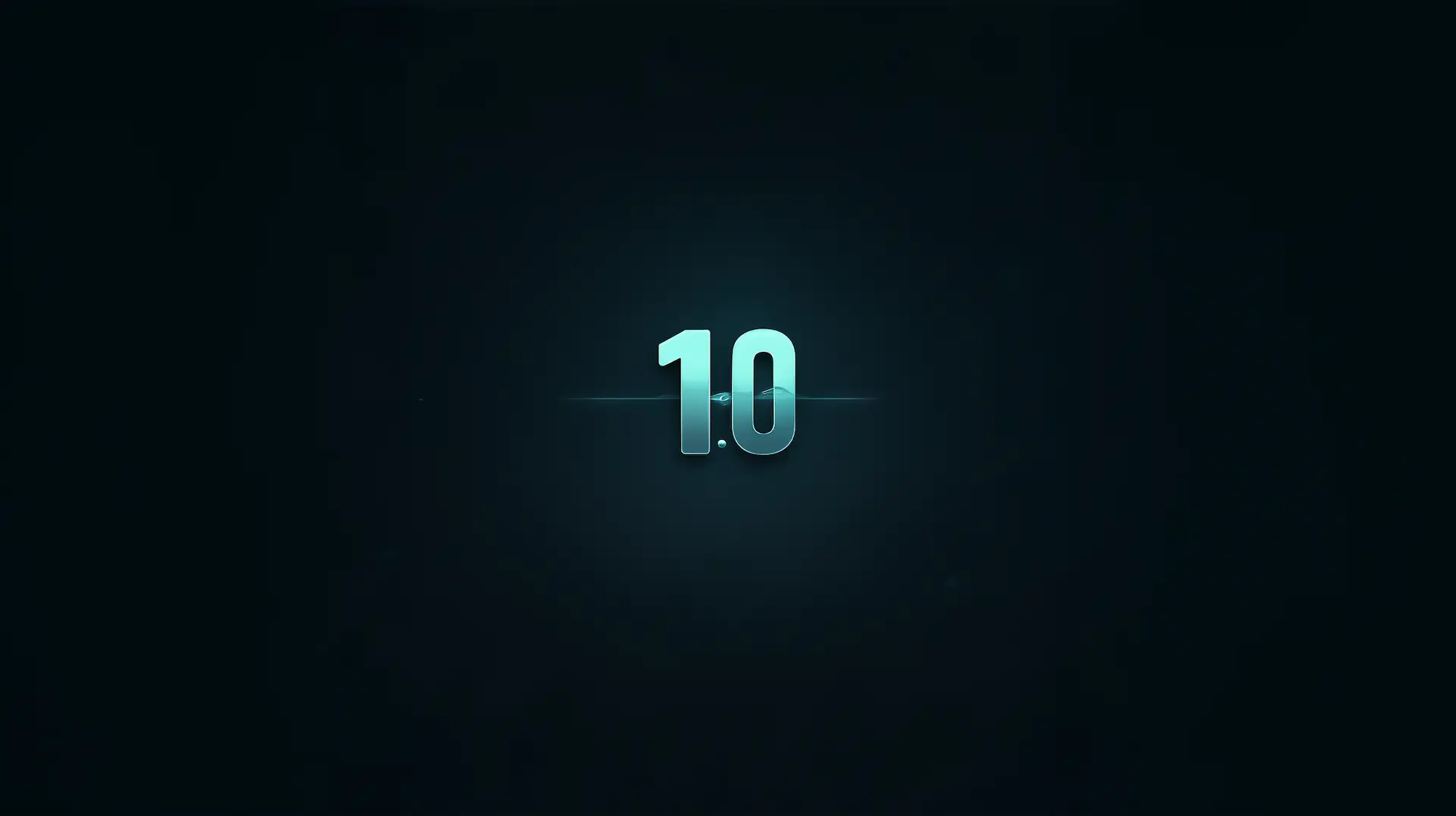We’ve been creating and innovating the next era of web development in WordPress for a full year. Here’s what we’ve accomplished:
- 2,657 total code commits (51 per week on average).
- Over 40 major releases (nearly one per week).
- Over 130 releases counting dev and patch releases.
- A usable product that far surpasses promises and expectations (more on this in a moment).
As you can see, we’ve been hard at work. And things are working so well that users consistently ask us why it’s not versioned as a 1.x product yet. They keep saying, “This doesn’t feel like a 0.x product at all. When is it going to be 1.0?” In some ways, the answer is simple, and in others, it’s complicated. Let’s discuss!
Here’s What We Promised for the First Year (and v1)
The most important part of this discussion needs to center around what was promised for delivery from September 2024 to September 2025. Here’s a screenshot from the pre-sale presentation:

As you can see, we promised users that they’d be able to use Etch to build “basic marketing brochure sites.” In other words: build websites with static content and perhaps blog posts. To do that within the vision of Etch, users would need to be able to:
- Author HTML
- Author CSS
- Interact with a reactive canvas
- Create core WP templates
- Have static content authored to Gutenberg as core blocks
- Have basic support for dynamic data for blog posts and templates (even though this is technically “dynamic”).
That’s what we promised. Nothing more, nothing less.
What We Actually Delivered in One Year
When we made our v1 promise, we had no idea what we would or wouldn’t be able to accomplish. We were simply committing to busting our asses, coding, innovating, thought-leading, and being good stewards of the pre-sale money that our amazing customer base gave us as an investment in our vision.
Thankfully—for everyone involved—we heavily under-promised and over-delivered.
As I write this post, Etch has:
- Full HTML authoring (with Emmet support).
- Basic HTML elements/blocks (Click-to-add so you can build sites without writing HTML).
- Element-Level CSS Authoring (with a full selector system, selector detection for pasted HTML, style collision system, advanced nesting, an innovative new approach to responsive development, powerful function helpers, and more).
- Global Stylesheets.
- An Integrated Variable Manager with Support for Collections.
- A Bidirectionally Synced Style Panel for Element Styling Without CSS.
- A Fully Reactive Canvas.
- Full JS Authoring (with an innovative element-level JS approach).
- An Integrated Template Manager With Template Creation.
- Innovative Component Functionality (with props, inline editing, and dynamic data support).
- An Innovative Approach to Loops (WP loops, JSON loops, saved loops).
- An Innovative Approach to Conditional Logic (block-based with support for simple and complex conditions).
- An Integrated Content Manager (create, delete, and navigate between posts and pages).
- Integrated Support for Creating CPTs.
- Integrated Support for Creating Custom Fields.
- Templating Support for CPTs, Custom Fields, and Custom Taxonomies.
- Full Support for Dynamic Data, including ACF-Support.
- Auto Block Authoring for Static Content.
- Auto Block Authoring for Components (as Synced Patterns with exposed props).
- Auto Block Authoring for Templates (as FSE Templates).
- Auto Block Authoring for Loops.
- Auto Block Authoring for Conditional Logic.
- Auto Block Authoring Support for Dynamic Data.
- Numerous Workflow Innovations for Modern Web Development.
- Copy/Paste Support for Static Content, Components, Loops, and Logic (both intrasite and cross-site).
Yep, that’s a lot. The reality is simple: If you compare what’s been delivered to what was promised, Etch was “v1” a while ago.
So, why haven’t we actually versioned it that way? There are two main reasons we haven’t labeled Etch as “v1” yet:
- We dramatically moved the goalposts on ourselves in terms of features so that we could keep delivering more and more value.
- Versioning is a very imperfect system that communicates certain things to certain people with too much left to interpretation.
Honestly, “v1” doesn’t mean what most people think it means.
Versioning is a Messy Way to Communicate Progress
Version numbers seem simple, but they’re a misleading way to communicate progress.
“1.0” often gets read as “finished and ready.” But a software product like Etch is never finished and was already “ready” prior to version 1.0. In fact, many of Etch’s features are more powerful, efficient, and intuitive than other tools that have been in development for years.
So, why not stay at 0.x for even longer then and just keep grinding? Because the 0.x designation has made some assume it’s not ready, not usable, and not stable. This is despite the fact that hundreds of sites already run it in production.
Clearly, version numbers come with a lot of baggage. So, what we’re attempting to do with 1.0 is trying to find a bit of middle ground with clear communication.
What “v1” Means for Etch
We’re slated to elevate Etch to v1 status on October 1st, starting with v1.0.0-alpha-1.
For us, “v1” communicates one thing: a commitment to trust in production-level stability. It’s not about the existence or depth of features, polish, or user experience—it’s about ensuring users can rely on Etch without fear of breakage.
To put the idea of “stable” on paper as a commitment, we need to make sure everything is buttoned up. Even though Etch is built with best practices and automated testing, it would be irresponsible to declare it perfectly safe for all levels of production without putting eyes on each major feature area again.
This process will be done in three phases: Alpha, Beta, and Release Candidate (RC).
Starting with v1.0.0-alpha-1, we commit to the following:
- 1.0-Alpha (October 1st)
- Freeze on all new features
- Preservation of all existing data
- Prioritization of critical bugs and security fixes
- 1.0-Beta (TBD)
- No breaking changes without a migration pathway
- Any deprecations will have a grace period for removal
- 1.0-RC (TBD)
- Locked and stable
- Only critical fixes will ship
We recommend using Alpha and Beta releases for low-consequence projects (as users have already been doing), such as personal sites or prototypes, to help us refine the product.
RC (Release Candidate) and 1.0 Stable releases are suitable for production client sites where stability is critical.
Looking Forward to 2026
Our hope is that we can move through the Alpha, Beta, and RC stages fairly quickly, get 1.0 stable out, and get back to feature development as soon as possible.
Etch has powerful momentum in the WordPress market. It’s capturing new users at a healthy rate, lots of people are reporting that they’re making a switch from other popular builders (namely Elementor, Beaver, Divi, Bricks, and Oxygen), and our user data shows a solid mix of advanced users, intermediates, and beginners.
We’re poised to see a major shift to using Etch in 2026 within the WP ecosystem. Exciting times!

